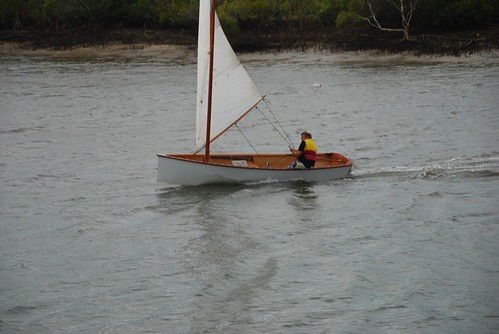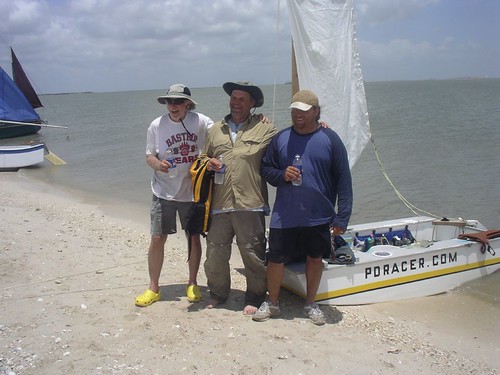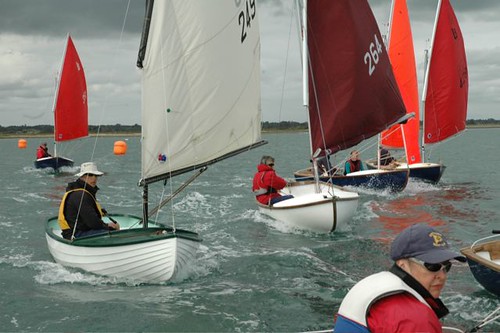This was a promising boat with input from a very experienced sailing group, however many of the features intended to make it safer actually made it less safe in capsize and if the crew was separated from the boat. The plan was discontinued.

What do you want in a Safe Long Distance Boat?
This list is where the unexpected problems were
- Lots of buoyancy
- Boat to come up dry
- Water ballast – either total or movable.
- Flat dry area for sleeping under a cover
This list conspired to cause several problems that made the boat less safe.
We can all learn from them and start to see some aspects that need to be planned around.
The biggest single learning point for sailing safety
It is not the design features of any particular boat that make a boat “safe”.
The dominating contribution to safety is the sailor knowing EXACTLY how a particular boat behaves in bad conditions and capsize.
There are two main outcomes of direct experience and practice.
- That the sailor knows what the priorities are and how to achieve them in the sudden appearance of a capsize. This needs to be an utterly familiar experience for a particular boat.
- With that experience the sailor will make a better call about whether sailing conditions are suitable for their particular boat. They may decide not to go out or return to shore or plan exit points for an expedition.
If you think the boat design can cover your ass without checking with practice…
You are MISTAKEN
The original thinking – written at the time.
Discussion was on the Ubeaut Woodwork Forum
This is a boat design I am currently working on. A single person distance racing/cruising boat. that can head away for a reasonable period, be fast enough around the buoys to be interesting or carry an extra person for daysails
There is a prototype on the way. Once I know the hull goes together I will be close to releasing the plans.
Video image can take a moment to load.
I am hoping it will be light enough to get onto a car roof rack and narrow enough to fit inside a 4ft Box Trailer.
Originally it was conceived as an expedition sailing boat that was within the strength of one person on shore and on the water. This creates quite severe restrictions on hull volume. Wide powerful boats become very tiring when they have to be righted from capsize or dragged ashore by one person or rowed against a headwind.
An extra person was planned to be ok for daysailing or shorter cruises.
It is derived from my experiences with two of my flat bottomed boat designs.
The sailing canoe BETH and the Goat Island Skiff.

These two boats proved beyond the shadow of a doubt that a simplified hullform could be made to sail very quickly indeed upwind and down with very little fuss and no slamming into waves. Videos.
So we took lessons about rocker, bottom shape and volume distribution from those and a number of other boats.

One of the other inspirations is a bit surprising.
My original thought about this boat was for RAID type events, but what I didn’t understand is just how specialised and complex the boats have become and how hard the crews are working.
However there is another way to spend time.
Earlier this year three of the little box shaped PDRacers finished a gruelling sail for 200 miles up the coast of Texas over a 5 day period.
They are the three chaps in the pic – Andrew Linn, Jason Nabors and John Wright. That’s one of the Puddleducks (they were in separate boats)
Anyway … they and everyone else had a great time travelling separately during the day but meeting up in the evenings to camp together. I suspect the puddle duckers spent a lot more time sleeping than most with their 10 to 12 hours on the water each day.

The point is to participate. So the thoughts of the OZ Woodwork group moved toward a cruising or expedition boat with the idea of something simple enough to build but faster than the PDRs.. Also with a self draining cockpit to save energy should one capsize.
The idea is to participate in a boat that is not a slouch, but not too much heavier or more complex to handle. That can be rowed OK if necessary too.
Point is … the ideas were settled and they then pressured me to make good all my comments by putting something together.
So am working furiously on a plan that just seems to grow and grow. The first prototype RAID41 is underway in the wilds of Scotland, built by the legendary Chris Perkins. (I threatened him with “legendary” inspired by some of the photos of his area)

The owner of the boat is Brian Pearson, who will club race out of Keyhaven in the UK (just past the Western mouth of the Solent) and race to participate in a number of RAID type events.
Brian has excellent technical knowledge of lug rigs because of weekly racing in the Lymington River Scow Class – pic right. Even I learned a thing or three after years of professing to be some sort of expert!
The weaknesses of the RAID41 design
Video image can take a moment to load.
I discontinued the development because, while the boat sails very nicely, there were problems recovering from capsize. The boat could be brought up from capsize but a single person would have trouble getting aboard again as the sides were too high to get over into the cockpit.
The prototype entered in the Texas 200 also sailed away from the sailor when it righted itself too quickly from capsize when he had released his hold on the boat and was stable enough upright to sail on without the sailor. The boat was recovered later, but it was a lesson that features meant to make a boat safer actually worked in the opposite direction.
To be fair its self righting may have been too effective because the boat was built with the two water ballast tanks linked. As you can see here Bryan was able to sit inside the boat while there is quite a bit of wind blowing.
Video image can take a moment to load.
Armchair Experts jump in Online.
There was some discussion that “some types of boats” would behave differently (eg, rounding up gracefully to be head to wind), but in 20 knot plus winds, waves and the possibility of a sheet being cleated) or catching on something during recovery it is pretty hard to predict what any stable boat would do without someone aboard to steer it.
Boats with ballast are particularly vulnerable to sailing away from a sailor in the water. Consider a lifeline or tether than can be released from either end.
This photo is from a real situation. It is a yacht, but alone in (well, until a moment ago) in a dinghy is not a place to find out either.

Hard Decision – after everyone worked so hard at the development.
The main reason for dropping the plan was the capsize recovery.
The reason for this was the self draining cockpit design. Because it raises the floor it means the sides of the boat have to be higher to allow enough space for rowing. Boats without the rowing requirement could be lower sided.
Also as the boat quickly gets rid of any water from the cockpit it floats very high when brought upright. I think a young and experienced sailor could mount the boat from the centreboard as the boat came upright … but it would be too difficult for many older or less experienced sailors.
The other side was that the false floor added a great deal to the building – for a simple boat it took a long time to build.
So I have discontinued the plan. I might derive something a bit different from the ideas of the RAID41. But a long time away at the moment I think.
The misunderstandings about buoyancy as safety in small boats
More is not more safe.
There are two basic options
- End buoyancy tanks at front and back of boat
- Side buoyancy tanks
These behave very differently.
End buoyancy tank behaviour in Capsizing Small Boats – safer in most ways
Positives of End Buoyancy – These are PROBABLE only but need to be checked for your speciific boat.
- Boat will lie deeper in the water on its side and upright
- Centreboard will be easier to reach.
- Boat will roll upright more easily,
- Boat will be low to the water and easy to get into.
- Boat will be low to the water and natural spar buoyancy can be sufficient to prevent turning turtle.
- Boat will not drift quickly in stronger winds
Negative –
- the boat will come upright with lots of water aboard which has to be bailed.
- Boat may be less stable until a fair bit of water is removed.
Side Buoyancy tank behaviour in Capsizing Small Boats – poses difficulties if overdone.

Lets go through the same list as for End Buoyancy.
In the negative list there are some things for every designer to check and every new owner to test
Positives of Side Tank Buoyancy in small boats
- boat may come up after capsize with little or no water aboard.
- Boat is stable after righting.
Negatives of Side Tank Buoyancy in Small boats
- Boat will float high on its side in the water.
- Centreboard will be much harder to reach from the water. On the 4ft wide Oz Goose it can be quite a reach but doable – be aware of wider boats and TEST. FRESH WATER CAN MAKE A BIG DIFFERENCE TO HOW FAR A SAILOR CAN REACH UP.
- Boat will roll upright with more difficulty
- Boat will float high after righting and may not be easy to get into or hold onto (TEST)
- Boat will is much more likely to turn turtle as boat leans on floating spars with greater pressure – so they sink
- Boat will catch the wind and can drift quickly in stronger winds (TEST)
Remember, as above) that ballast (water or other ballast) is not necessarily your friend after capsize while you are in the water. It can mean the boat is able to sail if you lose your hold and the boat upright can move quickly.
Oh, but I am a great sailor and can climb over the side onto the centreboard
So can I, but it doesn’t happen that way in every situation.

Positive outcomes.
One of the big learning experiences was just how much building is involved in a self draining design. It is really like building two hulls the way we went about it.
Much better is to use a fully filleted internal layout rather than using timber and myriad bevels.
The result has been a push to using duct tape for assembly when the panels are lowly stressed (usually twist is the culprit for building stress into the design) a method that has been used some of my simplified design range (Oz Gooose, OzRacer RV and the Quick Canoes)
Michael